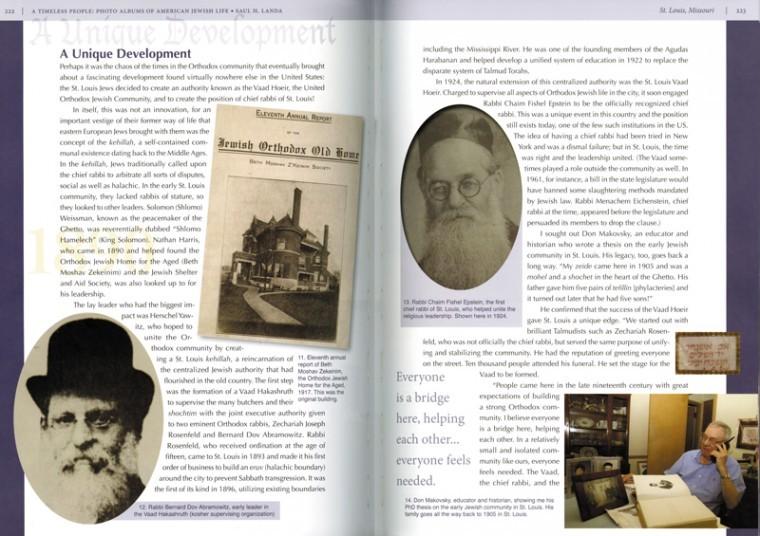St. Louis among communities featured in new book on American Jewish life
Published June 22, 2011
Saul H. Landa of East Brunswick, N. J., is a Jewish mother’s dream: he is both a rabbi and a dentist! He has also been a superb photographer of Jewish subjects for over 35 years, and he bring those talents to the fore in his just-published, handsome coffee table book, “A Timeless People: Photo Albums of American Jewish Life” (Geffen Publishing House, $50).
Landa’s book does not pretend to be a comprehensive work of scholarship on the American Jewish community and its history. In “A Timeless People,” Landa gives full credit to such Jewish historians as the late Dr. Walter H. Ehrlich, whose “Zion in the Valley” remains the definitive two-volume history of the Jewish community of St. Louis, and interviews local Jewish historian Donald Makovsky, who wrote the first monograph on Joseph Philipson, the first known Jew to arrive in St. Louis back in 1807.
ADVERTISEMENT
Instead of traveling over the same terrain as traditional Jewish historians, Landa shares his beautiful photographs and colorful anecdotes on 18 select Jewish communities in America—including St. Louis. The photographs, both vintage and recent provide a vivid portrait of the 18 representative communities.
The chapter on St. Louis, which is introduced by a serene photograph of the Gateway Arch, notes how the city became the home of the first synagogues west of the Mississippi, with the founding of United Hebrew Congregation in 1837 and B’nai El in 1855. The material included in the chapter on St. Louis gives a full history of the local Orthodox community and includes rare photographs of Rabbi Hyim Fischel Epstein, the first Chief Orthodox Rabbi of St. Louis and Rabbi Menachem Zvi Eichenstein, who served for many years in that position. There is also a discussion of Rabbi Bernard Illowy of United Hebrew Congregation, who became the first rabbi to serve a pulpit in St. Louis.
We also learn, during this 150th anniversary of the American Civil War, that by the outbreak of the conflict in 1861, there were only 5,000 Jews living in St. Louis (compared to the 60,000 today). “Only one was known to have owned slaves,” writes Landa. He adds, “A Jew from St. Louis, August Bondi, was one of the most outspoken opponents of slavery in the United States,” and joined other abolitionists in joining with John Brown, who raided Harper’s Ferry.
In each of the communities covered in his lavishly illustrated book, Landa surveys several specific institutions, mainly synagogues and day schools, but also such attractions as the Jewish museums in Milwaukee and Philadelphia, and discusses the Jewish newspaper that serves the greater Denver community, The Intermountain Jewish News, whose editor, Rabbi Hillel Goldberg, is interviewed in the book.
ADVERTISEMENT
There are amusing and enlightening anecdotal nuggets hidden throughout this super-sized book. We learn, in the chapter on Memphis, that Elvis Presley had substantial positive ties with the Jewish community, and that Memphis DJ George Klein, who played many of The King’s early records, was best man at Elvis’s wedding, and Elvis reciprocated at his. There is also a discussion of Elvis Presley’s Jewish great-grandmother, whose ancestry has caused some to claim that Elvis was Jewish by reason of having had an unbroken line of Jewish grandmothers and other female ancestors through his own mother. Indeed, Elvis always wore a chai necklace and his mother’s grave at Graceland is graced with a Jewish star.
Again, this is not a book of scholarly history, and it could benefit from an index in future printings. But for a superb bar or bat mitzvah or Hanukkah gift, “A Timeless People” is picture perfect. It will make a fine contribution to the library or coffee table of any Jewish home.
















